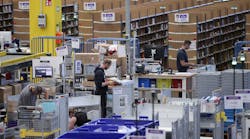Attention, American factory workers! Pretty soon the person who bosses you around all day is going to tell you that it’s time to update your wardrobe.
No, I’m not talking about your significant other and no, you won’t have to spend half the day in various outlet mall dressing rooms.
I’m talking about your actual boss. And this fashion makeover, consisting of the latest in smart wearable devices, will make you a smarter, safer (and maybe even stronger) worker. To quote the classic men’s suit commercials, “You’re going to like the way you look. I guarantee it.”
That’s because the cool gadgets from Dick Tracy and Mission: Impossible you wished you had as a kid could very well become part of your work uniform before the end of the decade. Current incarnations include the Apple Watch and Epson’s Moverio BT-2000 Smart Headset.
By 2019, the International Data Corporation (IDC) estimates 155.7 million wearables will be shipped out. Considering they project 72 million this year alone, there could be half a billion wearables by then. Granted, many of those will be from Fitbit, the biometric wrist device maker that owns more than a third of the exploding market.
But in four years, the smart wearables that will give you the floor vision of LeBron James are poised to dominate the market.Last year, smart wearables accounted for a paltry 16% of the market,according to the IDC. The research company projects a 46% share this year, and 57% in 2019.
Such a smart phone-level leap in technology will only increase availability and product selection while decreasing cost. And the tech synergy across brands, previously seen during the communications revolution and current Internet of Things explosion, will only serve to make wearables a necessity for forward-thinking companies.
"Smart wearables like the Apple Watch and Micosoft's HoloLens are indicative of an upcoming change in computing, and the transition from basic to smart wearables opens up a slew of opportunities for vendors, app developers, and accessory makers," says Jitesh Ubrani, senior research analyst, Worldwide Mobile Device Trackers.
One of the big issues is making sure this tech boom doesn’t become a time-suck or safety hazard for workers in dynamic and possibly dangerous environments. Angry Birds and foundries are a bad combination.
Savvy manufacturers understand the risk and keep the devices utilitarian, such as the XOEye XOneindustrial glasses, which feature a record-only mode, but not playback to stream Game of Thrones. And they want to stay as close to your normal ensemble as possible.
"At a device level, it was important to us not to add something to an employee's uniform," says C. Aaron Salow, CEO of XOEye Technologies. "We wanted to replace something workers already wear rather than add a clip-on or some other type of awkward contraption."
The next logical step in increasing productivity involves overcoming workers’ physical limitations: human augmentation. It’s not on the market yet, but it is more science-soon than science-fiction.
One promising entry in this untapped field is the Titan Arm, an upper body exoskeleton created at the University of Pennsylvania.
source: TitanArm.com
One use is to help rehabilitate injured limbs by measuring range of motion, but the website lists an alternate use: "Each year, thousands of workers must take leave due to injuries triggered by heavy lifting; with augmented strength, workers could avoid harmful situations."
That sounds like the ominous opening text to some post-Apocalyptic cyborg movie, but it’s more likely to end up as our product of the week in four years or so — and give you super strength.
So please remember to stay proud of your blue-collar and keep an open mind to upgrading the rest of your ensemble. Soon you might just be considered the most fashion forward person in your family. And you can always think of us as your J. Peterman catalog for the latest wearable trends. Just don’t expect us to have a “Who Wore It Better” section anytime soon.











